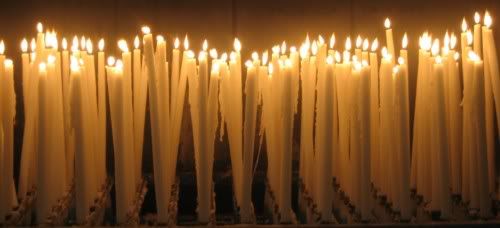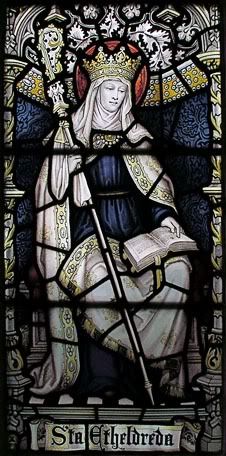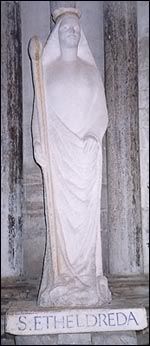Today, June 23, we celebrate the feast day of Saint Etheldreda (also known as Saint Audrey, 636-379), ascetic, queen, and foundress of the “double monastery” at Ely. Against earthly pressures, and through divine intervention, Saint Etheldreda maintained her personal consecration to the Lord, remaining a virgin and engaging in ascetic pursuits despite her noble station. Her perseverance in faith and commitment to a life of prayer and service is remarkable still today.
Born in Northumbria, the daughter of a king, Etheldreda was brought up in a God-fearing household. From an early age, Etheldreda had but one goal: to consecrate herself entirely to the Lord through entrance into a religious order. Etheldreda longed to fully serve with her life, her wealth, and her actions. Her father, on the other hand, had other plans for her. For political reasons, Etheldreda was married (at quite a young age) to a prince named Tonbert, from who she received a track of land on the Isle of Ely. For three years the couple lived together, and due to her young age and commitment to sanctity, Etheldreda was able to maintain her purity. Upon Tonbert’s untimely death, she relocated to the Isle of Ely, where she intended to devote herself to entirely spiritual pursuits.
However, it was not to be. Her father, again sensing political opportunity, arranged for a second marriage, this time to the young son of the powerful king of Northumbria, Egfrith. Etheldreda obeyed her father’s wishes, but chose to live in the royal palace as a sister to the king, rather than a wife. This was not problematic, due to the youth of the boy, who would sit at Etheldreda’s feet, learning Scripture from her. For twelve years, Etheldreda engaged in purely ascetic activities, forgoing the accoutrements and privilege of her position, and maintaining her purity. Etheldreda became known for devoting her time to works of mercy and love, while observing a scrupulous regularity of discipline.
At the age of twenty-four, Egfrith ascended to the throne of Northumbria, becoming king. As Queen, Etheldreda delighted in the society of monks and nuns, and took care to invite and attract to her those most distinguished for learning and piety. Among these was St. Cuthbert, the young Prior of Lindisfarne, upon whose monastery she bestowed many gifts from her own private property. Over time, Etheldreda became friends with Saint Wilfrid, her confessor, who on her behalf, encouraged the king to allow her to retire for some years to the Convent at Coldingham Abbey. There, she lived as a sister, having received the veil from Saint Wilfrid himself. Her husband, the king, shortly after consenting to her departure from the royal court, changed his mind and pursued her. When Saint Wilfrid pleaded on her behalf, the king made his intentions known: he would find Etheldreda and bring her back to the court by force, where he would consummate his marital privileges.
Etheldreda fled toward her land on the Isle of Ely, with the king in pursuit. She took refuge on a headland on the southern coast of England where a miracle prevented further advance of the king. While she was standing on a large outcropping of rock, the tide rose such that it created an island of refuge for the saint, water surrounding her. Etheldreda remained in this island refuge for seven days, until her royal spouse, recognizing the divine will, agreed to leave her in peace.
Etheldreda, freed from her marriage, continued on her trek to the Isle of Ely. On one extremely hot day during her travels, legend tells us that Etheldreda was overpowered with fatigue. She stuck her staff into the ground and lay down to rest on the open plain. When she awoke, the staff had put forth leaves and branches, and it afterwards became a mighty oak tree, larger than any other for many miles around.
At length, after many days of weary walking, the saint arrived on her own lands in Ely. There, she established a “double monastery,” shepherding both nuns and monks. Saint Wilfrid appointed her abbess, and she governed the abbey for many years, serving as advisor to the pope and other Church officials during that time. Etheldreda ruled over her monastery for seven years, setting a great example of piety and abstinence and all other monastic virtues. Though of royal lineage, and having been delicately reared, Etheldreda abstained from all luxuries. She never wore any linen, but only rough woolen clothing. She denied herself the use of the warm bath, only using the bath that had already served the other nuns. Many of her old friends, relations, and courtiers followed her and her example, engaging in ascetic practices, discipline, and prayer. The monastery grew considerably under her holy leadership
Not only holy and a model of virtue in shepherding her people to the Lord, Etheldreda also was graced with the gift of prophecy. Most notable of her prophecies was that of her own death by plague, and the exact number of her monks and nuns who would be carried off by the same epidemic. True to her prophesy, Etheldreda died of a quinsy, a form of plague which led to the development of a large tumor upon her neck. Etheldreda, never complaining about the pain or the sight of the growth, regarded is as a punishment for her former love of fine clothing, and, in particular, for having worn jewels on her neck.
Seventeen years after her death, Saint Wilfrid and Saint Etheldreda’s physician discovered her body to be incorrupt. The incision that had been made into her tumor shortly before she died had miraculously healed in death. (Saint Etheldreda remains the patron of sufferers of throat complaints.) The linen cloths in which her body was wrapped were as fresh as the day she had been buried. Her body was placed in a stone sarcophagus and reburied at the Abbey. Unfortunately, the tomb of Saint Etheldreda was desecrated during the English Reformation, with only the incorrupt hand of the blessed saint surviving. Her relics remain at St Etheldreda's Roman Catholic church at Ely, where many miracles have been reported through her intercession.
The life of Saint Etheldreda reminds us that we cannot truly be servants of Christ when our souls are distracted by the pleasures and desires of the world. In her wisdom, Saint Etheldreda gave up her wealth, station, and privilege, instead choosing to live the ascetic life of a abbess, guiding people to Christ and contributing to His kingdom on earth. We might take a lesson from Saint Etheldreda today, examining what binds us to the world, preventing us from truly and fully serving our Creator.
Eternal God,
who bestowed such grace upon your servant Etheldreda
that she gave herself wholly to the life of prayer
and to the service of your true religion:
grant that we, like her,
may so live our lives on earth seeking your kingdom
that by your guiding
we may be joined to the glorious fellowship of your saints; through Jesus Christ our Lord. Amen.
Why pray the Rosary every day for a year?
Each time the Blessed Virgin has appeared-- whether it be to Saint Bernadette Soubirous at Lourdes; to Lucia, Jacinta, and Francisco at Fatima; or to Mariette Beco at Banneux-- she has asserted the importance, saving grace, and power of praying the Holy Rosary on a daily basis. Based upon her words, the Rosary is penance and conversion for sinners, a pathway to peace, an end to war, and a powerful act of faith in Jesus Christ. Pope Paul VI presented the Rosary as a powerful means to reach Christ "not merely with Mary but indeed, insofar as this is possible to us, in the same way as Mary, who is certainly the one who thought about Him more than anyone else has ever done."
To show us how this is done, perhaps no one has been more eloquent than the great Cardinal Newman, who wrote: "The great power of the Rosary consists in the fact that it translates the Creed into Prayer. Of course, the Creed is already in a certain sense a prayer and a great act of homage towards God, but the Rosary brings us to meditate again on the great truth of His life and death, and brings this truth close to our hearts. Even Christians, although they know God, usually fear rather than love Him. The strength of the Rosary lies in the particular manner in which it considers these mysteries, since all our thinking about Christ is intertwined with the thought of His Mother, in the relations between Mother and Son; the Holy Family is presented to us, the home in which God lived His infinite love."
As Mary said at Fatima, "Jesus wants to use you to make Me known and loved. He wishes to establish the devotion to My Immaculate Heart throughout the world. I promise salvation to whoever embraces it; these souls will be dear to God, like flowers put by Me to adorn his throne."

Subscribe to:
Post Comments (Atom)

















0 comments:
Post a Comment
Thanks for leaving a comment. If you wish to submit a prayer request, however, please do so above, using the "Contact" tab.